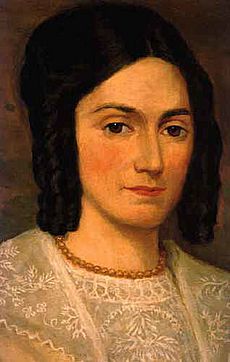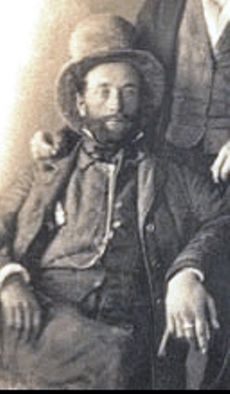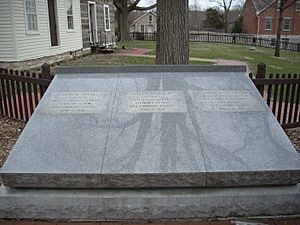Emma Smith facts for kids
Quick facts for kids Emma Hale Smith Bidamon |
|
|---|---|

Emma Hale Smith circa 1845 with David Hyrum Smith
|
|
| 1st President of the Female Relief Society of Nauvoo | |
| March 17, 1842 – 1844 | |
| Called by | Joseph Smith |
| Successor | Eliza R. Snow |
| Personal details | |
| Born | Emma Hale July 10, 1804 Harmony Township, Pennsylvania, U.S. |
| Died | April 30, 1879 (aged 74) Nauvoo House, Nauvoo, Illinois, U.S. |
| Resting place | Smith Family Cemetery, Nauvoo 40°32′26″N 91°23′31″W / 40.5406°N 91.3920°W |
| Notable works | A Collection of Sacred Hymns Latter Day Saints' Selection of Hymns |
| Spouse(s) | |
| Children | 11 (see Children of Joseph Smith) |
| Signature | |
Emma Hale Smith Bidamon (July 10, 1804 – April 30, 1879) was an American pioneer and a key leader in the early Latter Day Saint movement. She was the first wife of Joseph Smith, the founder of the movement. Emma also played an important role in the Community of Christ, a branch of the Latter Day Saint movement, after Joseph Smith's death.
In 1842, Emma was chosen as the first president of the Ladies' Relief Society of Nauvoo. This was a women's group focused on helping others. After Joseph Smith's death, Emma stayed in Nauvoo instead of moving with Brigham Young and other followers to Utah. She continued to support Joseph Smith's teachings throughout her life. She also supported her son, Joseph Smith III, when he became a leader in the Reorganized Church of Jesus Christ of Latter Day Saints (RLDS Church).
Contents
Emma's Early Life and First Marriage (1804–1829)
Emma Hale was born on July 10, 1804, in Harmony Township, Pennsylvania. She was the seventh child of Isaac and Elizabeth Hale. Her family had English roots, including some ancestors who came to America on the Mayflower. From a young age, Emma was active in her local Methodist church. She enjoyed reading the Bible and singing hymns.
Emma first met Joseph Smith in 1825. Joseph was staying with her family in Harmony while working to find a "Dream Mine." Even though the company didn't find any treasure, Joseph and Emma met secretly several times. When Joseph asked to marry Emma, her parents said no. They didn't approve of Joseph's work looking for treasure.
On January 17, 1827, Joseph and Emma left Emma's parents' home. They traveled to a friend's house in South Bainbridge, New York, and were married the next day. The couple then moved to Joseph's parents' home near Palmyra, New York.
The Golden Plates and the Book of Mormon
On September 22, 1827, Joseph and Emma went to a place now called Hill Cumorah. Joseph said he received a set of golden plates there. He hid the plates and later brought them home. Soon after, a group of people came looking for the plates, but they couldn't find them. This was seen as a special event for the couple.
The news about Joseph having the plates caused a lot of excitement. In December 1827, with help from Martin Harris, Emma and Joseph moved back to Harmony. They made up with Emma's parents, who helped them get a house and a small farm.
Once settled, Joseph began working on the Book of Mormon. Emma helped by writing down what he said. She later said she could feel the plates through a cloth and hear the metallic sound they made. On June 15, 1828, Emma gave birth to her first child, a son named Alvin. Sadly, he lived only a few hours.
In May 1829, Emma and Joseph moved to live with David Whitmer in Fayette, New York. On their way, they saw an old man who said he was going to Cumorah, then suddenly disappeared. Joseph believed this man was the angel Moroni. Joseph finished the Book of Mormon in Fayette, and it was published in March 1830.
"Elect Lady" and the Early Church (1830–1839)
On April 6, 1830, Joseph Smith and five other men officially started the Church of Christ. Emma was baptized on June 28, 1830.
In July 1830, Joseph received a special message, now known as Doctrine and Covenants section 25. This message called Emma Smith an "elect lady." It also said Emma would be given the power to teach from the scriptures and speak to the church. She was also asked to create a collection of hymns for the church.
Emma and Joseph returned to Harmony for a short time. However, their relationship with Emma's parents became difficult again. The couple then moved to live with other church members. They lived with the Whitmers, then with Newel K. Whitney's family in Kirtland, Ohio, and later on a farm owned by Isaac Morley.
Family Life and Challenges
On April 30, 1831, Emma gave birth to twins, Thaddeus and Louisa, but they died soon after. On the same day, another woman, Julia Clapp Murdock, died after giving birth to twins, Joseph and Julia. Their father, John, gave these babies to Emma and Joseph to raise.
In September 1831, the Smiths moved to John Johnson's home in Hiram, Ohio. In March 1832, the infant Joseph died after an attack on Joseph Smith's home.
On November 6, 1832, Emma gave birth to Joseph Smith III in Kirtland. He was the first of her own children to live to adulthood. A second son, Frederick Granger Williams Smith, was born on June 29, 1836. While the Kirtland Temple was being built, Emma helped organize housing and clothing for the workers.
Emma's strong feelings about avoiding tobacco and alcohol influenced her husband. His prayers about healthy living led to a teaching called the "Word of Wisdom." Also in Kirtland, Emma's first collection of hymns was published for the church.
During a financial crisis in 1837, a bank Joseph and other church leaders started failed. This caused many problems for the church and the Smith family. Joseph felt he needed to leave Kirtland for his family's safety. On January 12, 1838, he left for Missouri, and many church members followed.
Emma and her family also moved to a new Latter Day Saint settlement called Far West, Missouri. There, on June 2, 1838, Emma gave birth to Alexander Hale Smith. Soon after, conflicts in Missouri led to Joseph's arrest and imprisonment. Emma and her family, along with most other church members, were forced to leave the state. She crossed the frozen Mississippi River in February 1839.
Life in Nauvoo (1839–1844)
Emma and her family stayed with friends in Quincy, Illinois, until Joseph escaped from prison in Missouri. The family then moved to a new Latter Day Saint settlement in Illinois that Joseph named "Nauvoo." On May 10, 1839, they moved into a log house they called the "Homestead."
On June 13, 1840, Emma gave birth to a son, Don Carlos. Both he and his uncle, Don Carlos Smith, died the next year. The Smiths lived in the Homestead until 1843, when a larger house, the "Mansion House," was built. Emma ran a hotel from a part of this house, often hiring young girls who needed work as maids.
Leading the Relief Society
On March 17, 1842, the Ladies' Relief Society of Nauvoo was officially formed as a women's group for the church. Emma became its first president. She helped name the organization the "Relief Society."
Emma was known for her strong leadership in this role. She believed the main goal of the Relief Society was to uphold good morals in the community. She encouraged women in Nauvoo to confess their mistakes openly. She served as president until 1844. The group was formed to help the poor and improve the good qualities of women in the community. Emma also helped organize food and clothing for the men building the Nauvoo Temple. She even traveled to present a request to the Illinois governor on behalf of her people, who had faced difficulties in the state.
Challenges and Joseph's Death
By 1842, rumors about plural marriage (polygamy) and other practices began to spread. Emma publicly spoke out against polygamy. She denied that her husband was involved in it. As president of the Ladies' Relief Society, she signed a petition with many other women in 1842, stating that Joseph Smith was not connected to polygamy. She also approved a public statement in October 1842 that spoke against polygamy and denied her husband's involvement.
In June 1844, a newspaper called the Nauvoo Expositor was destroyed by the town marshal on orders from the town council, which included Joseph Smith. This event led to Joseph's arrest and imprisonment in Carthage, Illinois. On June 27, 1844, a group of about 200 armed men attacked the jail. Joseph and his brother Hyrum were both killed.
Later Years in Nauvoo (1844–1879)
After Joseph's death, Emma was a pregnant widow. On November 17, 1844, she gave birth to David Hyrum Smith, her last child with Joseph. Joseph had been in charge of the church's money, so his personal money was mixed with the church's finances. He also had debts when he died, leaving Emma with the responsibility to pay them. Separating the church's debts and property from Emma's personal finances was a long and difficult process.
There were also debates about who should lead the church after Joseph. Emma wanted William Marks to become the new leader. However, a church meeting on August 8 voted for the Quorum of the Twelve Apostles to lead. Brigham Young, the president of this group, then became the main leader of the church in Nauvoo.
Emma's relationship with Brigham Young became difficult. Some of Emma's friends and many members of the Smith family distanced themselves from Young's followers. Conflicts between church members and their neighbors continued to grow. Eventually, Young decided to move the church to the Salt Lake Valley. When he and most of the Latter Day Saints left Nauvoo in early 1846, Emma and her children stayed behind.
Nearly two years later, on December 23, 1847, Emma married Lewis C. Bidamon, a close friend. A Methodist minister performed the wedding. Bidamon moved into the Mansion House and became a stepfather to Emma's children. Emma and Bidamon did not have any children together. They tried to run a store and continue using their large house as a hotel. However, Nauvoo had too few residents and visitors for these businesses to be very successful. Emma and her family owned a lot of land but didn't have much money.
Emma and her children continued to live in Nauvoo as Latter Day Saints who didn't join any specific group. Many believed that her oldest son, Joseph Smith III, would one day become a leader like his father. When he said he felt called by God to lead a "New Organization" of the Latter Day Saint church, Emma supported him. She and Joseph III traveled to a meeting in Amboy, Illinois. On April 6, 1860, Joseph III was accepted as the president of the Church of Jesus Christ of Latter Day Saints. This church later added "Reorganized" to its name in 1872 and became known as the Community of Christ in 2001. Emma became a member of the RLDS Church.
Emma and Joseph III returned to Nauvoo after the meeting. He led the church from there until moving to Plano, Illinois, in 1866. Joseph III asked his mother to help create a hymnal for the new church, just as she had for the early church.
Emma and Bidamon bought and fixed up a part of the unfinished Nauvoo House in 1869. Some visitors from Brigham Young's group came from Utah to visit Emma at this house. Emma died peacefully in the Nauvoo House on April 30, 1879, at age 74. Her funeral was held on May 2, 1879, in Nauvoo.
Hymns and Hymnals
Emma Smith, along with W. W. Phelps, put together a Latter Day Saint hymnal. It was published in 1835 and was called A Collection of Sacred Hymns, for the Church of the Latter Day Saints. It had 90 hymn texts but no music. Forty-eight of the hymns were written by Latter Day Saints, and the rest were from other Protestant groups. The borrowed hymns were often changed slightly to fit the beliefs of the early church. For example, Hymn 15 changed Isaac Watts's Joy to the World from a Christmas song to a song about Jesus Christ's return. Many of these changes and new songs were credited to W. W. Phelps.
Emma also put together a second hymnal with the same title. It was published in Nauvoo, Illinois, in 1841 and contained 304 hymn texts.
When her son Joseph III became president of the RLDS Church, she was asked again to create a hymnal. Latter Day Saints' Selection of Hymns was published in 1861.
Emma's Stance on Polygamy
In a book about Emma, authors Linda King Newell and Valeen Tippetts Avery wrote that Emma saw some of Joseph Smith's marriages to multiple wives. However, throughout her life, Emma publicly said that her husband was not involved in the practice of polygamy. She even denied it on her deathbed.
Emma Smith stated that she first learned about a teaching on polygamy being linked to Joseph Smith when she read about it in a booklet in 1853. Many Latter Day Saints who joined the RLDS Church in the Midwest had left Brigham Young's group because they were against polygamy. Emma's continued public denial of the practice supported their views. Being against polygamy became a key belief of the RLDS Church. Over the years, many RLDS Church historians have continued to state that the practice started with Brigham Young.
Images for kids
-
Statue of Joseph and Emma Smith in Salt Lake City
See also
 In Spanish: Emma Smith para niños
In Spanish: Emma Smith para niños












